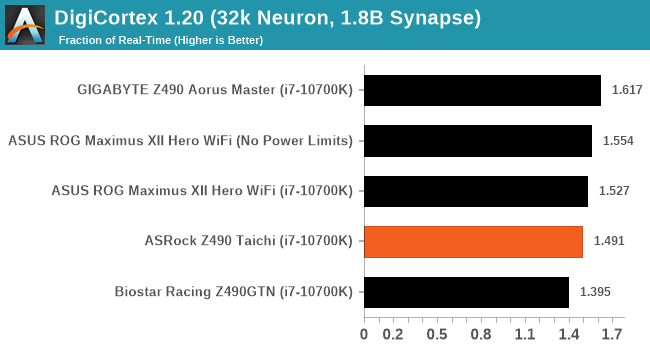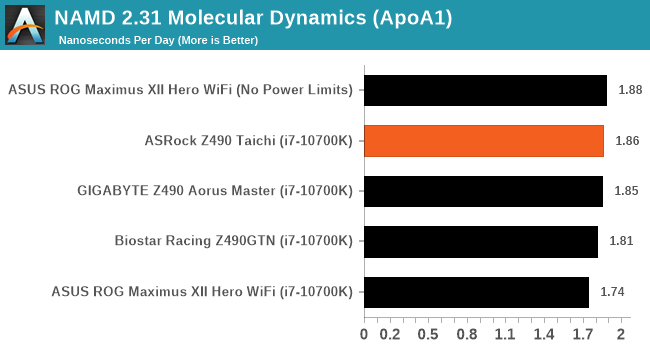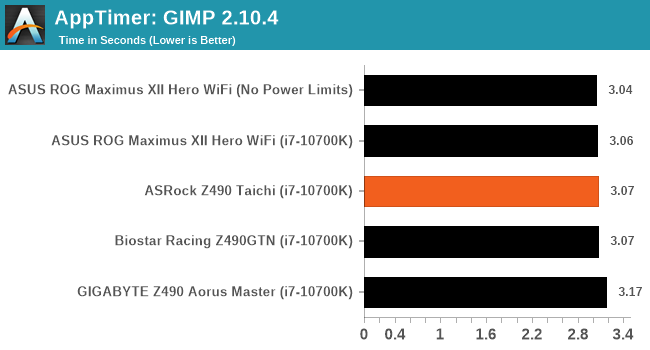The ASRock Z490 Taichi Motherboard Review: Punching LGA1200 Into Life
by Gavin Bonshor on May 27, 2020 9:00 AM ESTCPU Performance, Short Form
For our motherboard reviews, we use our short form testing method. These tests usually focus on if a motherboard is using MultiCore Turbo (the feature used to have maximum turbo on at all times, giving a frequency advantage), or if there are slight gains to be had from tweaking the firmware. We put the memory settings at the CPU manufacturers suggested frequency, making it very easy to see which motherboards have MCT enabled by default.
For Z490 we are running using Windows 10 64-bit with the 1909 update.
Update: A Note About Z490 and Turbo
Normally we test our motherboards with out of the box settings. This means that the performance will get boosted based on whatever default algorithm each motherboard vendor implements with regards turbo time and boost power. Intel actively encourages this - the numbers it puts in for turbo time and turbo power are recommendations, rather than specifications, and Intel wants motherboard vendors to engineer their products to the turbo and power that each vendor deems acceptable for their product. As a result, a lot of motherboards will implement an aggressive turbo algorithm.
For this generation, ASUS has done something different. ASUS' enthusiast motherboards offer two different options on first boot: Intel recommendations, or ASUS recommendations. This means that there is a small performance delta between the two, especially for ASUS' high-end motherboards. ASUS has put this into the product based on customer feedback and how motherboard vendors have slowly drifted over the last decade to well beyond what Intel recommends.
For our testing methodology, we try to leave as much as we can on default, because this is part of what makes a motherboard different to any other, and the motherboard vendor has to decide how aggressive it must be. Also, for non-enthusiasts who daren't enter the BIOS, or understand even what turbo or a CPU or what memory channels are, they will just end up with the non-XMP default settings. It is unclear what such a person might select when presented with the ASUS default option.
At this point we have included the results from selecting Intel's recommendations on ASUS' boards. Based on feedback, we are in the process of including both sets of data in our Z490 reviews. We were planning to cover it in depth in our first ASUS Z490 review, but please bare with us while we update our results for this review. We will still cover it in depth in the ASUS review.
Rendering - Blender 2.7b: 3D Creation Suite
A high profile rendering tool, Blender is open-source allowing for massive amounts of configurability, and is used by a number of high-profile animation studios worldwide. The organization recently released a Blender benchmark package, a couple of weeks after we had narrowed our Blender test for our new suite, however their test can take over an hour. For our results, we run one of the sub-tests in that suite through the command line - a standard ‘bmw27’ scene in CPU only mode, and measure the time to complete the render.

Rendering – POV-Ray 3.7.1: Ray Tracing
The Persistence of Vision Ray Tracer, or POV-Ray, is a freeware package for as the name suggests, ray tracing. It is a pure renderer, rather than modeling software, but the latest beta version contains a handy benchmark for stressing all processing threads on a platform. We have been using this test in motherboard reviews to test memory stability at various CPU speeds to good effect – if it passes the test, the IMC in the CPU is stable for a given CPU speed. As a CPU test, it runs for approximately 1-2 minutes on high-end platforms.

Rendering - Crysis CPU Render
One of the most oft used memes in computer gaming is ‘Can It Run Crysis?’. The original 2007 game, built in the Crytek engine by Crytek, was heralded as a computationally complex title for the hardware at the time and several years after, suggesting that a user needed graphics hardware from the future in order to run it. Fast forward over a decade, and the game runs fairly easily on modern GPUs, but we can also apply the same concept to pure CPU rendering – can the CPU render Crysis? Since 64 core processors entered the market, one can dream. We built a benchmark to see whether the hardware can.
For this test, we’re running Crysis’ own GPU benchmark, but in CPU render mode. This is a 2000 frame test, which we run over a series of resolutions from 800x600 up to 1920x1080. For simplicity, we provide the 1080p test here.

Point Calculations – 3D Movement Algorithm Test: link
3DPM is a self-penned benchmark, taking basic 3D movement algorithms used in Brownian Motion simulations and testing them for speed. High floating point performance, MHz, and IPC win in the single thread version, whereas the multithread version has to handle the threads and loves more cores. For a brief explanation of the platform agnostic coding behind this benchmark, see my forum post here.

Neuron Simulation - DigiCortex v1.20
The newest benchmark in our suite is DigiCortex, a simulation of biologically plausible neural network circuits, and simulates activity of neurons and synapses. DigiCortex relies heavily on a mix of DRAM speed and computational throughput, indicating that systems which apply memory profiles properly should benefit and those that play fast and loose with overclocking settings might get some extra speed up. Results are taken during the steady-state period in a 32k neuron simulation and represented as a function of the ability to simulate in real time (1.000x equals real-time).

NAMD ApoA1
One frequent request over the years has been for some form of molecular dynamics simulation. Molecular dynamics forms the basis of a lot of computational biology and chemistry when modeling specific molecules, enabling researchers to find low energy configurations or potential active binding sites, especially when looking at larger proteins. We’re using the NAMD software here, or Nanoscale Molecular Dynamics, often cited for its parallel efficiency. Unfortunately the version we’re using is limited to 64 threads on Windows, but we can still use it to analyze our processors. We’re simulating the ApoA1 protein for 10 minutes, and reporting back the ‘nanoseconds per day’ that our processor can simulate. Molecular dynamics is so complex that yes, you can spend a day simply calculating a nanosecond of molecular movement.

Application Load: GIMP 2.10.4
One of the most important aspects about user experience and workflow is how fast does a system respond. A good test of this is to see how long it takes for an application to load. Most applications these days, when on an SSD, load fairly instantly, however some office tools require asset pre-loading before being available. Most operating systems employ caching as well, so when certain software is loaded repeatedly (web browser, office tools), then can be initialized much quicker.
In our last suite, we tested how long it took to load a large PDF in Adobe Acrobat. Unfortunately this test was a nightmare to program for, and didn’t transfer over to Win10 RS3 easily. In the meantime we discovered an application that can automate this test, and we put it up against GIMP, a popular free open-source online photo editing tool, and the major alternative to Adobe Photoshop. We set it to load a large 50MB design template, and perform the load 10 times with 10 seconds in-between each. Due to caching, the first 3-5 results are often slower than the rest, and time to cache can be inconsistent, we take the average of the last five results to show CPU processing on cached loading.












57 Comments
View All Comments
lmcd - Wednesday, May 27, 2020 - link
Honestly this is the most inane post I've ever read. Times haven't changed for the better, Raven Ridge support took over a year after the SoC was released. I own two Raven Ridge devices. I would know.Even when AMD support hits mainline, it's in such a late kernel version that you better hope this "sane" distro you're referring to is willing to backport support in an update.
Dunno what you mean about the Nvidia driver being painless to use. Its Wayland support is still comparatively unstable in Gnome and pushes KDE Wayland support from mediocre to bad. It also requires extra build tools.
I can't edit posts but I explained a key usage of nested Hyper-V. "Anyone who wants to use the Windows 10X emulator needs it unfortunately." There's also plenty of other features that use Hyper-V these days from WSL2 to Windows Sandbox, so the antiquated views on Hyper-V are also quite dated. Times have changed for the better, and Hyper-V is very much part of the present.
Congrats on your condescension though! It almost masks how wrong you are.
Dug - Wednesday, May 27, 2020 - link
Why in the world do you insist on benchmarking Non-UEFI POST Time when no one will use that?TheinsanegamerN - Thursday, May 28, 2020 - link
Because not everyone is you and there are those of us that DO use it. Wow, what an amazing thought.Dorkaman - Thursday, May 28, 2020 - link
I would love to see UEFI post time AND Windpows clean knstall boot time. My old Asus Rampage V Extreme was very slow (40s post+boot no mem test hybrid) and the new Asus ROG Maximus XII Extreme is also very slow.My Gigabyte Z390 Aorus Master posts+boots in 10+5 seconds.
Dug - Wednesday, June 3, 2020 - link
Why would you be buying new equipment for outdated OS's that aren't supported?If that's the case, the boot time is irrelevant, and my post still stands. Why even bother benchmarking it?
Ranger1065 - Wednesday, May 27, 2020 - link
A good read, always a pleasure to peruse Anandtech. The aesthetics are not for everyone but personally I think it's a nice looking board. Out of my price range but Z490 is not for me anyway. As to Asus boards, I have an older Z97 Maximus Hero VII and a Z390 Prime. Both great boards that have given me no significant issues.Jorgp2 - Wednesday, May 27, 2020 - link
Do the new CPUs have an additional 4x lanes from the CPU?I keep seeing boards that advertise 8,8,4 slots, with all of them coming from the CPU. And this motherboard for example that has the 4x gen 4 M.2, when the chipset does not have Gen 4
MDD1963 - Wednesday, May 27, 2020 - link
The specs I read said the top GPU slot would be capable of PCI-e 4.0 x16, ...and one of the M.2 slots...( perhaps I missed where it said all 4 might be capable fo PCI-e 4.0 x4 operation?_)Even with the aforementioned limits, more than enough for 99% of most folks....
Spunjji - Thursday, May 28, 2020 - link
Waiting to see how many people show up to the comments to wail about the tiny fans. After all, it wasn't anti-AMD sentiment that caused so many folks to show to all of the articles related to X570 boards (and a few that weren't) and do that, it was totally neutral concerns about longevity and noise.(Full disclosure - I am fully on-board with not wanting tiny fans on a motherboard... just feeling a little amused by the asymmetry of this. The only comment here so far on this topic has been a sensible one, not hysterical ranting.)
TheinsanegamerN - Thursday, May 28, 2020 - link
So you smugly, disingenuously re-categorize the arguments of others and think you're...clever? Funny? Intelligent?Now, here's points for asrock that might blow your mind, these are STANDARD FANS. You can go buy brand new noctuas to replace these and silence them while maintaining cooling performance. Guess what you couldnt do with x570 chipset fans? These fans also dont spin 24/7, only when needed, and the VRMs here get a LOT hotter then the x570 chipset did.
If X570 got into the 90C range without the active cooling (it doesnt) and they used standard 40mm fans (they dont) then the complaints would be baseless. But we saw how necessary those x570 fans really were. And oh hey, there are plenty of Z490 mtoherboards that dont use VRM fans! Just like that whole 1 X570 motherboard that cost like $700!